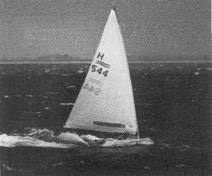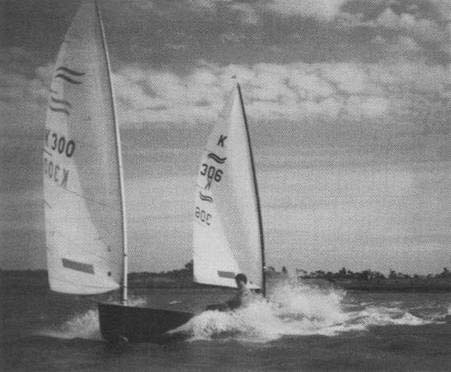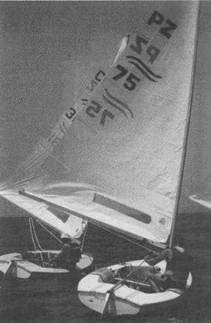| 30. Downwind Finn Sailing |
by Robert Deaves and Peter Mohilla |
|
While most races are won and lost on the upwind legs of the course, it has to be said that distance lost (or gained) offwind is much harder to regain upwind. Downwind speed is mainly dependent on good concentration and balance in light airs but is much more dependent on strength, technique and coordination in strong winds. Sailing a Finn offwind in a strong breeze can be a rewarding experience. The exhilaration of the acceleration and power, slicing through the water with spray flying over your head is something that has to be experienced first hand in order to be fully appreciated.
Balance and Steering
When sailing the Finn upwind in a breeze, vigorous steering is often needed to get the best performance. When sailing offwind, the opposite is usually the case, the rudder acting as a brake every time it is used. You should aim to use the rudder as little as possible, because every time you use it you will be slowing down the boat. Instead, steer by balancing the boat and by continuous trimming of the mainsheet. When there is a good breeze the boat should be kept level, but when there is very little it should be heeled to windward on a run and to leeward on a reach.
Heeling the boat helps you with steering the boat. The boat can be made to change course, gybe and tack faster just by using a combination of boat heel and sheet tension. Obviously the rudder is going to have to be used at some point but when you do use it, use it gently and smoothly so as to maintain boat speed. One final point is to make sure that your rudder system has no play in it at all. All joints should be tight fitting so that the boat responds immediately the helm is moved and not a few seconds afterwards.
|
Laminar Flow on a Run
What you should try to achieve on the run is as much of a steady laminar flow along the sail as possible, from the boom to the leach and from the mast to the leach upward. A laminar flow from across the boom upward is only possible in very light air and flat water, because it requires a rather unstable position of the hull. A second possibility is a laminar flow from the leach to the mast, which is possible and advantageous in medium wind, especially if you sail slightly by the lee. Whenever you want a laminar flow downwind, have your kicker fairly loose. In both cases lift up your centreboard completely, in order to reduce the wetted surface. Downwind the centreboard is only a disadvantage from the point of view of maximum speed, and only necessary from the safety point of view in order not to capsize.
In stronger wind you do not want to have a laminar flow. Therefore have your kicker tight. If your kicker is tight, the boat will have less tendency to death roll to windward.
|
 |
|
Sheeting
As soon as you are sailing free such that the boom is a few feet out from the gunwhale the sail can be sheeted directly from the boom using the last purchase of the mainsheet. This gives a much better feel on the sail. You can feel the puffs and lulls as they arrive and can respond to a change in direction much more quickly. Also, pumping is far more effective. As the wind increases you may have difficulty holding onto the single sheet unless you are strong enough. There are various ways that the sail can be sheeted - other than through the floor block with three purchases or directly from the boom.
|

|
1. Cleat the sheet in the sidedeck cleat or let the sheet run through the bottom block until it reaches the stopper knot (the latter is not practical on a close reach). Pick up the purchase from the traveller to the block on the boom and then sheet from the block on the boom. You will then be sheeting with one block in the system. The only problem with this method is when you have to change back to a normal sheeting method and the breeze has picked up. You then have to hold the purchase direct from the boom for a moment while you pick up the loose end and take up the slack. This can be problematical if you are sailing tight to the wind.
2. Alternatively, take the sheet from the other side of the floor block and then sheet straight from the block on the boom. You will then be sheeting with two blocks in the system.
|
|
When sailing in medium to strong winds, sheeting from the boom through less purchases gives an advantage when the sail is pumped because the pump will be sharper and therefore more effective in accelerating the boat. You will also have more 'range' through which the sail can be pumped. However this can take great strength and stamina and needs a strong arm and a good technique to be able to execute it effectively.
|
Light Winds
Below force 1 there is little danger of capsizing, so even the beginner can risk sailing fully for speed. One of the major objectives for going fast in light airs is to reduce the wetted surface area of the hull. All areas in contact with the water cause friction and hence induce drag on the hull. When on a ran sit well forward, sometimes even in front of the traveller so as to bring the wide transom area out of the water. At the same time heel the boat to windward. This reduces the overall area of hull surface which is immersed in water. This extreme technique is only used in very light winds. As soon as the wind increases, body weight will have to be brought aft again so that the rudder has enough grip on the water to be effective in steering the boat. Body motion in the boat should be kept to a minimum as every movement will shake what little wind there is from the sail. A steady flow of air over the sail is important at all times. When on a beam reach or tighter, the boat should again be trimmed bow down, but it should also be heeled to leeward so that the sail takes up its natural shape.
|
 |
|
The centreboard should be fully retracted when on a ran, and only slightly down when on a reach. As a general rule only put enough down to keep the boat moving in a straight line. If too little is down, the boat will tend to skid sideways. The centreboard still causes frictional drag so use as little as possible. Another important device is a strong JC strap to hold the boom out. Without one, the boat cannot be heeled to windward on a ran or broad reach without the boom falling back to the centreline.
|
 |
In light airs the sail needs to be flat with an open leech. Little or no kicker tension is ever required. A tight kicker would give a hooked leech and would kill boatspeed and cause the sail to fold in on itself, making it very difficult to fill and produce drive. Ease the inhaul to produce depth in the foot of the sail and continually adjust the sheet.
Increasing the Safety Margin
If the wind and the waves are building up, the helm position at the thwart without any centreboard is too dangerous. You have to make up your mind how to increase the safety margin. This can be done in different ways. You can sit further aft, you may lower the centreboard, you may tighten the kicker, you can avoid capsizing by holding the sail on one part only or on two parts of sheet instead of three, if you feel strong enough to do so, and pull before you capsize to weather. It is a question of your skill and strength, the wind force, the wave characteristics and their direction. Generally it boils down to a compromise between speed and safety, Lowering the centreboard gives better steering control and reduces the tendency for rocking, but increases the wetted surface drag. Pulling the kicker flattens the sail and reduces the danger of a death roll to weather, but reduces also the possibility for a laminar flow behind the sail. Sitting further aft reduces the danger of cutting under a wave and increases stability, but also increases the danger of whirls at the transom.
|
|
Medium Winds
As the wind increases when on a ran, more kicker tension is required to keep the leech behind the mast. If the leech is allowed to go in front of the mast, a twisting force is set up which can roll the boat into windward. However if the rolling can be controlled, this technique, combined with sailing slightly by the lee, can be fast. You must have twist in the sail to make sailing by the lee effective. To induce twist in the sail ease the kicker so that the leech moves out or forward. To reduce twist in the sail, tension the kicker to move the leech in or back. When sailing by the lee the wind flow along the sail reverses and flows from the leech towards the mast.
In the increased wind move your weight further aft to gain rudder control and to bring the bow out of the water (essential when it is windy enough to start planing). The sail may need to be flattened slightly when reaching otherwise the boat might prove hard to control. Play the gusts and the waves. Continually adjust the mainsheet. Ease it until the sail just luffs then haul in until the telltales stream, then ease until the sail just luffs and then do it again and again.
|
|